Top tips on buying a secondhand Manitou
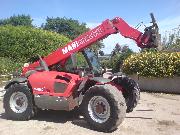
Manitou’s 6m reach telehandlers are by far the company’s best-selling farm-spec machines. Having been produced in various guises since about 1990 and updated in 2004, the MLT range’s most popular models have hovered around the 3t mark, so we’re on the hunt for a few different examples to get an idea of what you can find for your money.
Buying advice is provided by Simon Toone from Leicestershire Manitou and Claas tractor dealer, Sharnford Tractors, who has been selling Manitous for the past 17 years.
“I’ve taken in a lot of MLTs as trade-ins over the years and have occasionally been bitten by a machine that looks the part but ends up costing us a fortune when we get it back to the workshop,” he explains.
“It’s well worth getting out of the car and going through a few simple checks before you make your offer.”
1. General appearance
“If a machine looks well cared for, then it probably has been,” says Mr Toone.
“But don’t be fooled by appearances. A quick checkover of the basic mechanical details will soon diagnose a dud.”
Broken cab glass, missing worklights and smashed mirrors are indicators that loving care and attention hasn’t been lavished upon the potential purchase. According to its age, expect a few dents and scrapes. Condition should match the hours on the clock.
2. Cab
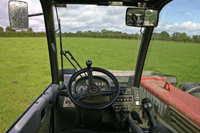 Jump up into the cab to check that everything is in good working order. Work methodically through all the machine’s functions including the boom, auxilaries, pick-up hitch, worklights, etc
Jump up into the cab to check that everything is in good working order. Work methodically through all the machine’s functions including the boom, auxilaries, pick-up hitch, worklights, etc
If something electrical is out of action, it’s worth whipping off the panel below the steering column to check for rodent residents that may have made the main wiring loom their home.
Having a working safe-load indicator is a requirement for the Health and Safety Executive and a lot of insurers. Manitou units have one button to silence the bleeping and another to test the system. If there’s a fault, alternate LEDs will light up. Best to get this checked out by an expert.
3. Steering
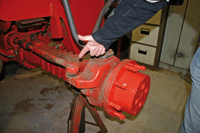 With the loader running, the steering should feel light. If it’s heavy, it could be the seals in the hydraulic system’s steering priority valve. This will take a fitter a couple of hours to sort.
With the loader running, the steering should feel light. If it’s heavy, it could be the seals in the hydraulic system’s steering priority valve. This will take a fitter a couple of hours to sort.
A cranked lever alongside the loader joystick switches between four-wheel-steering, two-wheel-steering and crab-steer. A rocker-switch to its left lights up when the wheels are aligned. Check this works, if not, it could mean faulty steering angle sensors which are hidden in the rams. Unevenly worn tyres are a good indicator that there’s been a long-term fault.
Drop the bucket onto the ground and lower the double-acting pick-up onto a block to lift all four wheels clear of the deck. Rock each one left to right to get an idea of play in the track-rod ends. Doing the same in a vertical plane will give an indication of how worn the axle king-pins and bushes are.
4. Brakes
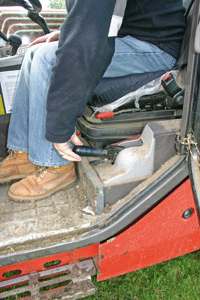 Manitou brakes are renowned for their stopping ability and rarely give any trouble. An MLT should pull up very sharply.
Manitou brakes are renowned for their stopping ability and rarely give any trouble. An MLT should pull up very sharply.
With the machine on a slope, check that the hand-brake works. Manitous have a twist-grip lever that allows adjustment from the cab. If it won’t hold, even after a decent amount of twiddling, it may be that the disc and/or pads are worn. The hand-brake is located on the front prop-shaft as it exits the main gearbox. It’s open to muck and baler-twine, so check that its not debris that’s causing the problem.
5. Tyres
New rubber for a telehandler will set you back between £1500 and £2000, so make sure you factor that in to the purchase price. All four tyres need to be replaced at once because permanent 4wd can cause shaft wind-up if rolling diameters aren’t matched up.
6. Driveline
Shuttle backwards and forwards. Clonks could indicate tired universal joints (UJs) on the prop-shafts which will inevitably have been wrapped in baler-twine and netwrap at some stage.
Again lift all four wheels clear of the deck and crawl underneath. Try to twist the shafts by hand – any play in the UJ yokes will immediately become obvious.
Next, put the machine into gear and hold it on the brakes. A clattering sound indicates worn bearings and UJs on the main engine output/angle box input shaft. Get underneath to check it and, while you’re there, inspect the fan belt for cracks and wear -it’s easiest accessed from below.
7. Engine
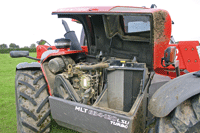 Perkins four-pot power plants rarely give trouble. Look out for any obvious leaks and check the filters for an indication as to when it was last serviced. A 1000-hour service costs about £400.
Perkins four-pot power plants rarely give trouble. Look out for any obvious leaks and check the filters for an indication as to when it was last serviced. A 1000-hour service costs about £400.
8. Boom and hydraulics
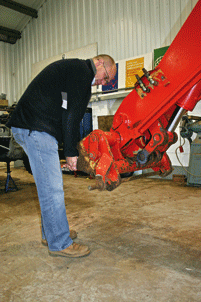 Tilt the attachment carriage right back so that the system pressurises. As this happens, the crowd ram displaces oil to the self-levelling compensator ram at the back off the boom. Because this is situated on one side, it has a tendency to pull the boom across as it pressurises. The amount that it moves will give an indication of worn the main pivot pin is.
Tilt the attachment carriage right back so that the system pressurises. As this happens, the crowd ram displaces oil to the self-levelling compensator ram at the back off the boom. Because this is situated on one side, it has a tendency to pull the boom across as it pressurises. The amount that it moves will give an indication of worn the main pivot pin is.
Load-sensing hydraulics should allow simultaneous operation of all boom functions at once.
Drop the bucket on the deck with the boom extended. Any slop in the nylon wear pads can be rectified relatively easily by slipping shims in behind the pads.
Grasp the attachment carriage and rock up and down. This should show up any slop in the pins and bushes. Check that the manual locking pin (a steel bar) is straight and slots in easily.
9. Transmission
There are two types of torque-converter transmissions fitted to MLTs. Most common is a four-speed manual, although higher-spec machines may have a five-speed twist-grip powershift.
Run the machine up the road and, if it’s the powershift version, make sure you get up to top speed so that the final automatic 4th to 5th change takes place. On manual versions, make sure the electric clutch dump buttons work on both the gear lever and main joystick.
10. Pick-up hitch
Check for wear in the hook and keeper. Also check to see it will lift the rear of the machine with a block placed underneath it. Hydraulic trailer brakes are a legal requirement.
* Thanks to the team at Sharnford tractors for their expert knowledge and assistance.
What to Pay?
- 1997, MLT 628-T, 6000hours, average condition £11,000-£13,000
- 2001, MLT 629-120-LS, 1600hours, good condition £19,000-£21,000
- 2003, MLT 629-120-LS, 3500hours, good condition £20,000-£22,000
- 2004, MLT 633-120-LS, 3000hours, good condition £24,000-£26,000
- 2007, MLT 634-120-LSU, 1000hours, excellent condition £32,000-£34,000
*Boom suspension adds £500, air-con £500, trailer brakes £500, 5-speed powershift £500 and hydraulic attachment locking £200-£300.
Replacement Parts Prices
- LH mirror and arm £40
- Safe Load Indicator control box £143
- Safe Load Indicator strain gauge £209
- Starter motor £255
- Fan belt £42
- Track-rod end £211
- Engine to transfer box shaft bearings £46
- Pins and bushes for attachment carriage re-build £294
- Main carriage pivot pin and back-plate £255
